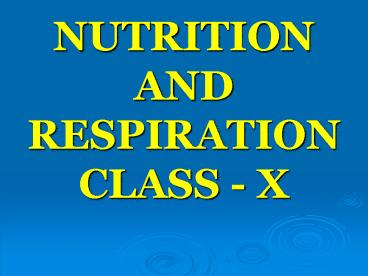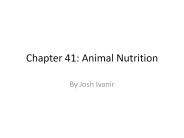NUTRITION AND RESPIRATION CLASS - X - PowerPoint PPT Presentation
1 / 46
Title:
NUTRITION AND RESPIRATION CLASS - X
Description:
NUTRITION AND RESPIRATION CLASS - X CARBON DIOXIDE (CO2) Air contains 0.03% of CO2. It is released by respiration, combustion of fossil fuels and microbial decomposition. – PowerPoint PPT presentation
Number of Views:977
Avg rating:3.0/5.0
Title: NUTRITION AND RESPIRATION CLASS - X
1
NUTRITION AND RESPIRATIONCLASS - X
2
LIFE PROCESS
- The basic functions performed by living organisms
to maintain their life on this earth are called
life processes. - The basic life processes common to all the living
organisms are - Nutrition and Respiration
- Transport and Excretion
- Control and Coordination
- Growth
- Movement and Reproduction
3
NUTRITION
- Nutrient It is a substance which an organism
obtains from its surroundings and uses it either
as an energy source or for biosynthesis of body
constituents. - Example- Proteins, Carbohydrate,Fats etc.
- Nutrition It is a process of intake of
nutrients as well as utilisation of nutrients by
an organism.
4
MODE OF NUTRITION
- Mode of nutrition means method of procuring food
or obtaining food by an organism. Depending on
the mode of obtaining food, all organisms can be
classified into two groups, - Autotrophic
- Heterotrophic
5
AUTOTROPHIC MODE OF NUTRITION
- Auto means self and troph means to nutrition,
thus autrotrophic means self nutrition. - It can be defined as a type of nutrition in which
organisms synthesise its own food - ( Organic material) from the simple inorganic
materials like carbon dioxide and water. - Exa Green plants, autotrophic bacteria
6
HETEROTROPHIC MODE OF NUTRITION
- The word hetero means other and troph means
nutrition, which means nutrition obtained from
others. - Heterotrophic nutrition can be defined as a mode
of nutrition in which an organism cannot make its
own food from simple inorganic materials like
carbon dioxide and water, and depends on other
organisms for its food. - Example- All animals, bacteria and fungi.
7
- Heterotrophic nutrition is of three types which
are as follows -- - Saprophytic Nutrition
- Parasitic Nutrition
- Holozoic Nutrition
8
SAPROPHYTIC NUTRITION
- The word sapro means rotten.
- Saprophytic mode of nutrition is a nutrition in
which an organism obtains its food from dead and
decaying organic matter. - Example- Fungi and bacteria
- Such organisms are called saprophytes.
9
PARASITIC NUTRITION
- The word para means others.
- The parasitic nutrition is a nutrition in which
an organism derives its food from the body of
another living organism(called its host). - The organism which obtains food is called
parasite and the organism from whose body food is
obtained is called host. - Example of parasite Plasmodium, Cuscuta,
roundworm
10
HOLOZOIC NUTRITION
- Holozoic nutrition means feeding on solid food.
- The holozoic nutrition is a nutrition in which an
organism takes the complex organic food materials
into its body by the process of ingestion, which
is subsequently digested and obsorbed. - Example Amoeba, frog, human beings.
11
NUTRITION IN PLANTS
- PHOTOSYNTHESIS The process by which green
plants make their own food ( like glucose) from
carbon dioxide and water by using sunlight energy
in the presence of chlorophyll, is called
photosynthesis. - Oxygen gas is released during this process.
- The overall equation of photosynthesis is
represented as follows - Sunlight
- 6CO2 12 H2O ?C6H12O6 6H2O 6O2
- chlorophyll
12
CLOROPLAST
13
STRUCUTE OF CHLOROPLAST
- STRUCTURE - In the chloroplast of higher plants,
- Stacks of thylakoids(lamellar structures) are
present which are called grana (sing.-granum). - Thylakoid is a flattened sac of membrane which
contains chlorophyll molecules responsible for
Photosynthesis. The Light dependent reaction (or
light reaction) of photosynthesis occurs in the
thylakoids.
14
- A thylakoid of one granum is connected to other
granum with the help of stroma lamellae (single
thylakoid). - The chloroplast is filled with a liquid called
stroma or matrix. The light independent reaction
(or dark reaction) occurs in the stroma of the
chloroplast. - A double membrane surrounds the entire
chloroplast.
15
CHLOROPLAST
16
PORTION OF THE LEAF
- LEAF SECTION
17
A PLANT CELL
18
CHLOROPHYLL
- Chlorophyll and carotenoid pigments are
photoreceptor molecules which play a key role in
photosynthesis. - The green colour of plant is due to the presence
of chlorophyll. - Different types of chlorophyll are
- Chlorophyll a, b, c, d, e and bacteriochlorophyll
- Chlorophyll a and b are most common and are found
in all plants. - Chlorophyll pigments are found inside
chloroplasts.
19
CHLOROPHYLL MOLECULE
20
CHLOROPHYLL
21
CAROTENE
22
PHOTOSYNTHESIS
- PHOTOSYNTHESIS The process by which green
plants make their own food ( like glucose) from
carbon dioxide and water by using sunlight energy
in the presence of chlorophyll, is called
photosynthesis. - Oxygen gas is released during this process.
- The overall equation of photosynthesis is
represented as follows - Sunlight
- 6CO2 12 H2O ?C6H12O6 6H2O 6O2
- chlorophyll
23
SOLAR RADIATION
24
RAW MATERIALS FOR PHOTOSYNTHESIS
- The raw materials for photosynthesis are
- 1) Chlorophyll
- 2) Sunlight
- 3) Carbon dioxide
- 4) Water
25
STOMATA
26
MECHANISM FOR PHOTOSYNTHESIS
- The entire process of photosynthesis can be
divided into two main stages. - 1) Light reaction Light dependant
- 2) Dark reaction Light independent
27
LIGHT REACTION
- When light strikes chlorophylls, photons are
absorbed which excite electrons of chlorophylls
to a higher energy level. The emitted electrons
travel through the electron transport chain
present in the chloroplast. The process requires
a number of electron acceptors - In this process ATP is synthesized from ADP and
inorganic phosphate. This ATP is used as a source
of energy during dark reaction.
28
- In light reaction photolysis of water takes
place. - 2H2O ? 4H O2 4e-
- The hydrogen ions which is released during
photolysis reduce the NADP molecule
(Nicotianamide adenine diphosphate) into NADPH2
which is also used during the dark reaction. It
is important to note that oxygen released during
photosynthesis comes from water.
29
PHOTOPHOSPHORYLATION
30
ATP MOLECULE
31
DARK REACTION
- The NADPH2 molecule as well as ATP(assimilatory
power) produced during the light reaction are
utilized in the stroma of chloroplast for
synthesis of carbohydrate from CO2. This is
called carbon fixation - In this process CO2 enters into a series of
reactions with Ribulose biphosphate ( five
carbon sugar). At the end carbohydrate is
synthesized and Ribulose biphosphate is
regenerated. This is called Calvin-Benson cycle.
After its discoverer Melvin Calvin Ande Benson.
32
(No Transcript)
33
FACTORS NECESSARY FOR PHOTOSYNTHESIS
- A number of factors affect the process of
photosynthesis, as a result of which productivity
is affected. These are - Carbon dioxide
- Water
- Chlorophyll
- Light
- Temperature
34
CARBON DIOXIDE (CO2)
- Air contains 0.03 of CO2. It is released by
respiration, combustion of fossil fuels and
microbial decomposition. - During early morning hours and evening hours, CO2
released in respiration is sufficient for
photosynthesis. At this stage, there is no
exchange of gases between the plant and the
environment. This is called compensation point.
35
- An increase in the concentration of CO2 upto 0.1
increases the rate of photosynthesis. - Higher concentration of CO2 decreases the rate of
photosynthesis.
36
WATER
- Plants absorb water and mineral salts through
root hair and pass it to the leaves through
xylem. - If there is less availability of H2O, then
stomata closes ( to reduce the water loss by
transpiration) and there is decreased CO2
absorption and sunlight absorption. - Therefore the rate of photosynthesis decreases.
37
CHLOROPHYLL
- Only cells having chlorophyll are photosynthetic.
There is no proportionality between the rate of
photosynthesis and amount of chlorophyll.
38
LIGHT
- White light consists of all the seven colours.
Highest rate of photosynthesis is seen in red
light and minimum in green light. Chlorophyll can
absorb violet, blue and red light rays. - The rate of photosynthesis increases at the lower
intensity of light and decreases in the stronger
intensity of light.
39
TEMPERATURE
- Photosynthesis is an enzymatic process. The
enzymes function within an optimum range of
temperature. - Lower temperature has an inhibitory effect on the
rate of photosynthesis because the enzymes are
inactivated. - Increase in temperature increases the rate of
photosynthesis but it ultimately inhibits
photosynthesis.
40
CARBON DIOXIDE
- The rate of photosynthesis increases with an
increase in carbon dioxide concentration upto a
certain level. - Beyond that, CO2 concentration has no effect on
the rate of photosynthesis. On the contrary it
decreases the rate.
41
NUTRITION IN AMOEBA
- Amoeba is a unicellular animal which feeds on
microscopic animals and plants that float in a
water body. - The mode of nutrition in amoeba is holozoic.
- The process of obtaining food in amoeba is termed
as phagocytosis. - The various steps of nutrition are ingestion,
digestion, assimilation and egestion.
42
AMOEBA
43
- Amoeba engulfs the food by forming pseudopodia.
- When the food is completely encircled and the
tips of encircling pseudopodia touch each other,
the membrane at that point dissolves. - The food is encaptured into the cell like a bag
called food vacuole. - Inside the food vacuole, the food gets digested
by digestive enzymes.
44
- The digested food diffuses into the cytoplasm and
is utilised by the cell. This is termed as
assimilation. - The undigested food remains in the food vacuole,
and is thrown out of the body. - This process is called egestion.
45
NUTRITION IN GRASSHOPPER
- Grasshopper is herbivorous which feeds mainly on
leaves of plants. - The mouth parts in grasshoppers are adapted for
biting and chewing.
46
DIGESTIVE SYSTEM OF GRASSHOPPER
- The digestive system of grasshopper can be
divided into - Foregut mouth, pharynx, oesophagus,
crop, salivary glands, gizzard - Midgut stomach, hepatic caeca
- Hindgut ileum, colon, rectum and anus
- ?Malphigian tubules are present in between midgut
and hindgut.































